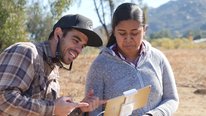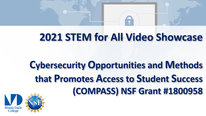Mobile Additive Manufacturing Platform for 21st Century STEM Workforce Enhanc...
NSF Awards: 1902437
2021 (see original presentation & discussion)
All Age Groups
The Rapid Response Additive Manufacturing Initiative (RRAMI) project was developed by Eric Wooldridge and Heather Beebe of Somerset Community College (SCC) in Kentucky to enable a statewide, variable location, rapid 3D printing response in the event of emergencies such as COVID-19, natural disasters, or other calamities to manufacture substantial amounts of critical supplies. Products that would no longer be available due to a breakdown of the conventional manufacturing supply chain will be produced, such as personal protection equipment (PPE), hardware components, or vital tools.
Related Content for Rapid Response Additive Manufacturing Initiative (RRAMI)
-
 2019Utilizing Additive Manufacturing Technology to Create Next-G
2019Utilizing Additive Manufacturing Technology to Create Next-G
Eric Wooldridge
-
 2018SF CALL: Computing for All Levels and Learners, Year 2
2018SF CALL: Computing for All Levels and Learners, Year 2
Eric Hsu
-
 2018Team STEM Project
2018Team STEM Project
Kasey Powers
-
 2022Enhancing Technician Education through Extended Pathways
2022Enhancing Technician Education through Extended Pathways
Christine Delahanty
-
 2019VolsTeach for Appalachia
2019VolsTeach for Appalachia
Lynn Hodge
-
 2021Basic Skills in U.S. Subbaccalaureate STEM Programs
2021Basic Skills in U.S. Subbaccalaureate STEM Programs
Wonmai "Maia" Punksungka
-
 2021Enhancing (and Broadening) Engineering Talent in Tennessee
2021Enhancing (and Broadening) Engineering Talent in Tennessee
Megan Davis
-
 2021STEM-CUREs Increase student access to research
2021STEM-CUREs Increase student access to research
Nichole Spencer
Playlist: ATE Videos Playlist
-
 2021Guitars, Rocketry, Robotics
2021Guitars, Rocketry, Robotics
Chelsea Carnes
-
 2017STEM-Inc
2017STEM-Inc
Jidong Huang
-
 2021Using Bioinformatics to Introduce Students to Biotech Career
2021Using Bioinformatics to Introduce Students to Biotech Career
Sharon Gusky
-
 2021MATE Competition: Students Engineering Real-World Solutions
2021MATE Competition: Students Engineering Real-World Solutions
Jill Zande
-
 2021VR: Sustaining Social Interaction STEM Engagement and Access
2021VR: Sustaining Social Interaction STEM Engagement and Access
Jonathan Beck
-
 2021Rapid Response Additive Manufacturing Initiative (RRAMI)
2021Rapid Response Additive Manufacturing Initiative (RRAMI)
Eric Wooldridge
-
 2020Preparing Technicians for the Future of Work
2020Preparing Technicians for the Future of Work
Ann-Claire Anderson
-
 2020Guitars, Rocketry, and Robotics ATE
2020Guitars, Rocketry, and Robotics ATE
Chelsea Carnes
-
 2020From Classrooms and Camps to College and Technical Careers
2020From Classrooms and Camps to College and Technical Careers
Sharon Gusky
-
 2020Promoting Interest in Drone Applications and Careers
2020Promoting Interest in Drone Applications and Careers
Wing Cheung
-
 2020Incorporating Geospatial Technologies into the Classroom.
2020Incorporating Geospatial Technologies into the Classroom.
Devon Russell
-
 2020Scaling Up the Automated Manufacturing Technician Pipeline
2020Scaling Up the Automated Manufacturing Technician Pipeline
Mason Lefler
-
 2020The Future Workforce Begins with a Spark
2020The Future Workforce Begins with a Spark
Jonathan Beck
-
 2020Controls Tech Barbie and her Smart Barbie Grand Hotel
2020Controls Tech Barbie and her Smart Barbie Grand Hotel
Deb Hall
-
 2021Increasing Opportunities for Underrepresented Minorities
2021Increasing Opportunities for Underrepresented Minorities
Diego Tibaquira
-
 2020Merry Mobile Robot Platform
2020Merry Mobile Robot Platform
Mahmood Lahroodi
-
 2020AMP-IT-UP: Inspiring middle school teachers in STEM
2020AMP-IT-UP: Inspiring middle school teachers in STEM
Meltem Alemdar

Megan Davis
I'd love to know more about your recommendations for the printers and software that worked so well (just a 5% failure rate!) for RRAMI. Do you have video of the printers in action?
Our college of engineering also had a face shield response effort, utilizing our laser cutter and purchased plastic materials: https://www.lipscomb.edu/news/peugeot-center-pi...
Eric Wooldridge
Eric Wooldridge
Professor
Hi Megan,
Thank you so much for your question!
I will attach a link to our recommendations for the 3D printers that we used during our Rapid Response Additive Manufacturing Initiative. I will also attach a link to our webpage that shows videos/pictures of the printers.
Link to recommendations: https://docs.google.com/document/d/1Ugh943g0vFg...
Link to RRAMI web page: https://somerset.kctcs.edu/news/2021/01152021-r...
I checked out the masks that your college of engineering made and they look great! If you have any other questions, please ask!
Shawn Anderson
Fabulous information!
Eric Wooldridge
Eric Wooldridge
Professor
Thank you!
Gerhard Salinger
Former Program Officer (NSF)
This is an interesting project and has lots of potential. What did the students learn? Was this project tied to a specific course? What roles did students play in this process? Did they design and redesign the product? Can this be used in project-based learning for students in which they not only have to learn about the technology of the process but also design, business issues and employability skills?
Eric Wooldridge
Eric Wooldridge
Professor
Hi Gerhard,
Thank you for your questions!
We would love to start incorporating this project with our students! However, the RRAMI project was completed by instructors at different colleges across Kentucky.
Our 3D printing courses include design, business issues and employability skills! We give our students all the tools to be successful in the additive manufacturing field. Most of our students take what they learn and apply it to their own job, even if their job is not in the AM field. We have many stories from former students who improved their job somehow with additive.
John Fraser
Your video made me really happy because it was directly targeted at solving a crisis through engineering. The presentation was clear, succinct and didn't need bells and whistles to deliver the thesis. Congratulations.
Eric Wooldridge
Eric Wooldridge
Professor
Thank you!
Joselina Cheng
Professor
Excellent way to promote 3D technology!! Logistically, how were facial shields and masks were delivered to the frontline workers, hospitals, nursing homes, etc.? What are the metrics for measuring the broader impacts? Thanks in advance for sharing.
Eric Wooldridge
Eric Wooldridge
Professor
Thank you for your questions!
We quarantined the products for about 3 to 4 days, and then had volunteers to come and pick up boxes of the face shields for delivery. We used social media to handle a lot of the coordination of the incoming materials as well as maintaining regional awareness and targeting needs.
The broader impacts are being tracked through overall statewide student enrollment in our additive literacy courses, the number of sites adopting our curriculum, and site reporting of projects that are occurring through additive manufacturing.
We especially use social media to track student employment in the additive field and what former students are doing with the technology once they hit the workforce.
Every new product that enters an Etsy store that is 3D printed, every small business that adopts low cost additive manufacturing for product or equipment enhancement, every job posting that we can capture. we try to collect it all through social media and encourage our students to share what they are doing and what they see being done with the technology.
We will be talking about some of this on 5-14-21 for those interested in virtually attending: 4th Virtual Symposium on Affordable Additive Manufacturing
Link: shorturl.at/szEF4
Yolanda Abel
Yolanda Abel
Associate Professor
The RRAMI project is a great example of innovation and being responsive in the moment. How has this experience influenced the way in which instructors across Kentucky approach their teaching and projects they do with students?
Eric Wooldridge
Further posting is closed as the event has ended.